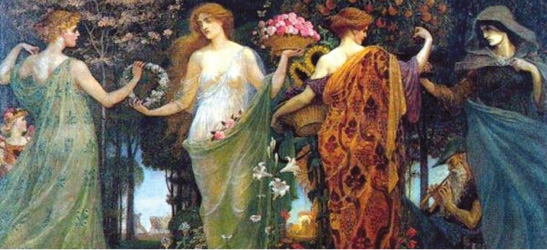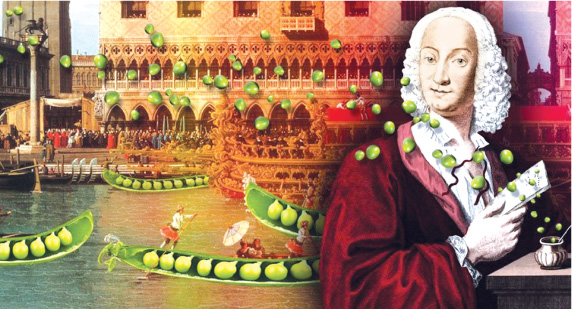VIVALDI FAMOUS for Four Seasons
Antonio Vivaldi was born in Venice on March 4, 1678. Though ordained
a priest in 1703, according to his own account, within a year of being
ordained Vivaldi no longer wished to celebrate mass because of physical
complaints (“tightness of the chest”) which pointed to angina pectoris,
asthmatic bronchitis, or a nervous disorder. It is also possible that
Vivaldi was simulating illness - there is a story that he sometimes left
the altar to quickly jot down a musical idea in the sacristy....
In any event he had become a priest against his own will, perhaps
because in his day training for the priesthood was often the only
possible way for a poor family to obtain free schooling.
 Though he wrote many fine and memorable concertos, such as the Four
Seasons and the Opus 3 for example, he also wrote many works which sound
like five-finger exercises for students. And this is precisely what they
were. Though he wrote many fine and memorable concertos, such as the Four
Seasons and the Opus 3 for example, he also wrote many works which sound
like five-finger exercises for students. And this is precisely what they
were.
The reputation of baroque Venice as a musical centre was one of the
highest in Europe, due largely to its four conservatories of music.
Beginning as charitable foundations they developed gradually as seats of
musical
learning, and by the early 1700s their excellence was unrivalled.
This was confirmed by Charles de Brosses, French Magistrate and
President of the Parliament de Dijon, who visited Italy in 1739,
reporting in his *Lettres
familières écrites d’Italie* and published posthumously in 1799, that
“the Ospedali have the best music here. There are four of them, all for
illegitimate or orphaned girls whose parents cannot support them. These
are brought up at the State’s expense and trained exclusively in music.
Indeed they sing like angels, play the violin, flute, organ, oboe,
cello, bassoon...
Vivaldi was employed for most of his working life by the Ospedale
della Pietà, generally accepted as being the best of the four Ospedali,
and many of his concerti were indeed exercises which he would play with
his many
talented pupils. The brilliance of some solo writing in his “student
exercise” concertos testifies to the extremely high standard attained by
“his” ladies.
Vivaldi’s relationship with the Ospedale began right after his
ordination in 1703, when he was named as violin teacher there. Until
1709, Vivaldi’s appointment was renewed every year and again after 1711.
Between 1709 and
1711 Vivaldi was not attached to the Ospedale. Perhaps in this period
he was already working for the Teatro Sant’ Angelo, an opera theater. He
also remained active as a composer - in 1711 twelve concertos he had
written were published in Amsterdam by the music publisher Estienne
Roger under the title *l’Estro armonico* (Harmonic Inspiration).

In 1713, Vivaldi was given a month’s leave from the Ospedale della
Pietà to stage his first opera, *Ottone in villa*, in Vicenza. In the
1713-4 season he was once again attached to the Teatro Sant’ Angelo,
where he produced an opera by the composer Giovanni Alberto Rostori
(1692-1753).
As far as his theatrical activities were concerned, the end of 1716
was a high point for Vivaldi. In November, he managed to have the
Ospedale della Pietà perform his first great oratorio, *Juditha
Triumphans devicta
Holofernis barbaric*. This work was an allegorical description of the
victory of the Venetians (the Christians) over the Turks (the
barbarians) in August 1716.
At the end of 1717 Vivaldi moved to Mantua for two years to take up
his post as Chamber Capellmeister at the court of Landgrave Philips van
Hessen-Darmstadt. His task there was to provide operas, cantatas, and
perhaps concert music, too. His opera *Armida* had already been
performed earlier in Mantua and in 1719 *Teuzzone* and *Tito Manlio*
followed. On the score of the latter are the words: “music by Vivaldi,
made in 5 days.”
Furthermore, in 1720 La Conduce o siano Li veri amici was performed.
In 172O Vivaldi returned to Venice where he again staged new operas
written by himself in the Teatro Sant’ Angelo. In Mantua he had made the
acquaintance of the singer Anna Giraud (or Giro), and she had moved in
to live with him.
Vivaldi maintained that she was no more than a housekeeper and good
friend, just like Anna’s sister, Paolina, who also shared his house.
In his Memoires, the Italian playwright Carlo Goldoni gave the
following portrait of Vivaldi and Giraud: “This priest, an excellent
violinist but a mediocre composer, has trained Miss Giraud to be a
singer. She was young, born in Venice, but the daughter of a French
wigmaker. She was not beautiful, though she was elegant, small in
stature, with beautiful eyes and a fascinating mouth. She had a small
voice, but many languages in which to harangue.” Vivaldi stayed together
with her until his death.
Vivaldi also wrote works on commission from foreign rulers, such as
the French king, Louis XV - the serenade *La Sena festeggiante*
(Festival on the Seine), for example.
This work cannot be dated precisely, but it was certainly written
after 1720.
In Rome Vivaldi found a patron in the person of Cardinal Pietro
Ottoboni, a great music lover, who earlier had been the patron of
Arcangelo Corelli.
And if we can believe Vivaldi himself, the Pope asked him to come and
play the violin for him at a private audience.
Earlier, in the 1660’s, musical life in Rome had been enormously
stimulated by the presence of Christina of Sweden in the city. The
“Pallas of the North,” as she was called, abdicated from the Swedish
throne in 1654. A few years later she moved to Rome and took up
residence in the Palazzo Riario.
There she organized musical events that were attended by composers
such as Corelli and Scarlatti. Other composers, too, such as Geminiani
and Handel worked in Rome for periods of time. Like them, Vivaldi
profited from the favorable cultural climate in the city.
Despite his stay in Rome and other cities, Vivaldi remained in the
service of the Ospedale della Pietà, which nominated him “Maestro di
concerti.”
-Internet |

